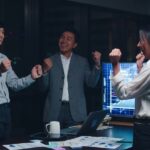By: Alex Hales
The leaders driving today’s most ambitious ventures are constantly immersed in digital activity. The same devices that track their performance and connect them to opportunities also keep them engaged in an ongoing flow of updates, notifications, and metrics.
For many, the day begins with a phone screen before coffee and ends with a final inbox refresh before switching off the lights. In this digital world, “taking a break” often means replacing one form of stimulation with another—moving from a project dashboard to a news site, or from a sales call to a quick scan through social media. These pauses may appear to offer rest, but the brain remains active, leaving limited space for true mental recovery.
Over time, the effects of this constant stream of activity can accumulate: mental clarity may fade, creative ideas could slow down, and flexibility might diminish. Executives report feeling mentally “full” before lunch, with decision-making quality often decreasing as the day progresses. Senior leaders notice their tolerance for ambiguity shrinking, preferring faster, safer choices, while creative directors find their ideas becoming repetitive.
In response, many high performers are rethinking their breaks—opting for moments free from screens and apps, with activities that offer physical, tactile engagement, providing a mental reset without the need for complex problem-solving.
When the Digital Hustle Becomes Cognitive Static
Continuous Connectivity and Its Toll
Modern professional life often leaves little unstructured time. Meetings are packed with minimal gaps, collaboration tools keep every conversation within reach, and analytics dashboards update in real-time. While these systems help enhance coordination and responsiveness, they also eliminate natural pauses in the workday that once served as mental resets.
The small moments that used to be used for processing thoughts—walking between buildings, waiting for a document to print—are now consumed by clearing notifications or scanning headlines. Though these interruptions may seem minor, the mental switching they require can prevent the brain from entering slower processing states that foster reflection, synthesis, and deeper insight.
Subtle Signs of Overload
The effects of sustained cognitive load often appear gradually. A founder might struggle to recall points from a recent meeting, or a creative lead may find themselves repeatedly rewriting a proposal without making real progress. Decision-making tends to rely more on immediate impulses rather than thoughtful evaluation.
These signals rarely trigger rest for high achievers. Instead, they often lead to efforts to push harder—adding another optimization tool, restructuring schedules, or compressing workflows. But what’s missing may not be efficiency—it’s deliberate breaks that allow the mind to reset before diving back into focused tasks.
The Return of Tactile Play
Purpose-Driven Physical Engagement
Across co-working hubs, creative studios, and executive offices, physical play is becoming an intentional part of the workday. A fintech startup in Austin features a communal board game table in its lounge. A design agency in Shoreditch keeps drawers stocked with sketch pads, mechanical puzzles, and hand tools. An architecture firm in Singapore has a model-building station in its open plan to encourage informal pauses throughout the day.
The appeal lies in the immersive, non-digital nature of these activities: the glide of a pencil on paper, the click of a puzzle piece, the control of moving a game piece—each offering a mental shift from abstract data to tangible interaction.
One example comes from the UK-based home leisure brand, Home Games Room, which designs non-digital experiences for daily use. Their approach reflects a broader movement to integrate tactile engagement into the work environment itself, making it part of the daily rhythm—not just an occasional retreat.
Adaptable for Any Setting
Analog engagement can be tailored to fit almost any professional environment. In a home workspace, it might involve a brief woodworking project or a few minutes sketching before moving into the next meeting. In offices, a low-maintenance tactile station can serve as a casual waypoint between meetings.
Distributed teams have also found ways to synchronize these breaks, whether through shared calendar holds or mid-shift intervals. Co-located teams may gather for short tabletop activities, while remote colleagues engage in their own tactile rituals at the same time. These shared pauses create a collective rhythm, allowing everyone to shift modes with less resistance.
In settings where speed and precision are crucial, consistency matters. Structured breaks allow the brain to release one task and transition to another more smoothly, improving focus and adaptability.
What the Brain Gains When the Screen Goes Dark
Activating Underused Neural Pathways
Cognitive science supports the idea that alternating between focused work and restorative activities can enhance mental stamina and creativity. However, many modern “breaks”—such as watching videos or scrolling social media—don’t provide true restoration. The brain stays in an input-driven state, processing information at a rapid pace with minimal sensory variation.
Engaging in physical, sensory-rich activities changes the equation. Dr. Wendy Suzuki, a neuroscientist at New York University, notes that passive screen-based breaks often fail to allow the brain to recover—they keep neural circuits in a state of overstimulation. Instead, activities like walking in nature, drawing by hand, or playing physical games engage motor and sensory regions that remain dormant during screen work.
These fine motor actions, from aligning puzzle pieces to handling weighted objects, may help ease cognitive load and improve mental flexibility.
The Value for Strategic Decision-Makers
These tactile activities may not just lower stress—they can enhance executive function. By offering different sensory input, they create space for the brain’s default mode network to work in the background, forming connections and insights that wouldn’t arise during concentrated effort.
For decision-makers managing complex priorities, these subtle shifts might be vital. A few minutes spent with a mechanical puzzle before a negotiation, or shaping clay before a design sprint, could recalibrate attention, reduce emotional intensity, and improve judgment quality.
Micro-Breaks, Macro Impact
Micro-breaks are intentional pauses, lasting just long enough to alleviate mental strain without disrupting momentum. They’re most effective when physical, self-contained, and repeatable throughout the day.
At a Manchester-based technology firm, developers work in 90-minute cycles, punctuated by five-minute dexterity games. The practice appears to reduce bug recurrence and shorten review cycles. Similarly, a London design director reports improved clarity and steadier delivery under questioning after incorporating brief physical exercises before presentations.
When adopted across teams, micro-breaks can influence more than individual output. They foster collaboration and restore a cooperative tone during tense projects. Shared physical activities also encourage informal exchanges, promoting problem-solving outside formal meetings.
These breaks create a culture where mental recovery is viewed as an integral part of performance, rather than a sign of fatigue. Over time, such practices could help retain talent in competitive sectors where burnout is a persistent risk.
Cultural Signals from Tokyo to Berlin
Urban Models of Analog Integration
In Tokyo, business districts have pioneered café spaces that offer scheduled “analog hours.” Wi-Fi is paused, and customers are offered simple craft kits, such as origami or model assembly. These spaces attract both freelancers and corporate teams, who book tables for off-site sessions.
Berlin’s creative sector has integrated analog activities directly into work environments. In one popular co-working hub, a central game table is in regular use, with short sessions programmed at set times. This activity fosters both social and professional interactions, creating informal touchpoints for team members.
Home and Hybrid Applications
In London, home workspaces are designed to prioritize non-digital engagement. Major outlets have profiled home studios that maximize natural light, with making areas physically separate from screen-based zones. The Guardian highlights the benefits of creating “tech-free zones” within the home to promote focus and support mental recovery.
For hybrid professionals, these spaces serve as transitional zones, allowing the mind to shift from digital intensity to hands-on, sensory-rich activities. The result is the intentional integration of analog play into the daily rhythm, balancing digital work with physical engagement.
The Leadership Case for Structured Play
In fast-paced environments, leaders often set the tone for how time is managed. When executives incorporate structured, hands-on activities into their schedules, they indicate that mental recovery is just as important as operational discipline.
Some high-growth startups now integrate “creative reset” sessions into board meetings or quarterly planning events. These sessions involve short, purposeful activities like a simple game, collaborative sketching, or small-scale construction—offering a mental reset before tackling intense cognitive tasks.
Executive coaches suggest that these resets could improve emotional regulation, a critical factor in negotiations and crisis management. By briefly redirecting focus to a low-stakes activity, leaders might recalibrate, reducing the likelihood of impulsive decisions under pressure.
Early adopters in this space often find that the perceived time cost of these activities is outweighed by the improvements in meeting quality, decision-making, and team cohesion. Over time, these practices could lead to more sustainable performance, helping organizations maintain momentum over the long term.
Sector-Specific Adoption: What It Looks Like in Practice
In finance, portfolio managers take short tactile breaks between market updates, reporting fewer impulsive decisions and steadier performance. In technology, software teams at a San Francisco AI firm use analog breaks after sprint reviews to improve focus and speed up onboarding.
In design and architecture, studios incorporate sketching and model-building sessions into workflows. In legal practice, New York litigation teams use tactile breaks to reduce fatigue during trial preparation.
How High Performers Structure Analog Time
Conversations with executives and creatives who use analog play intentionally reveal several common patterns:
Scheduled Placement: Analog breaks are placed at natural inflection points—after a meeting or before a key decision.
Defined Duration: Breaks are short, typically 5-15 minutes, with a clear endpoint to prevent them from disrupting focus.
Purpose-Linked Activities: Activities align with the desired outcome—calming before a presentation or energizing for creative work.
Physical Accessibility: The tools for analog play are kept nearby—on desks, in shared lounges, or in designated “reset zones.”
Measuring the Payoff
Studies show that even brief physical activity can lower stress hormones and improve attention for up to half an hour afterwards. The British Psychological Society reports similar benefits from brief, task-specific cognitive breaks, noting positive effects on both accuracy and speed of complex decision-making. One engineering consultancy tracked improvements such as reduced error rates and faster client turnaround times after introducing regular tactile breaks.
Play as Infrastructure for Success
In competitive industries, performance is measured by outcomes—deals closed, products shipped, strategies executed. Yet the capacity to achieve these outcomes relies on the quality of thinking behind them. Sustained high performance requires clarity, adaptability, and resilience—all of which are enhanced by integrating analog play into daily work.
Neglecting this practice may lead to a faltering pace—not due to lack of drive, but because the conditions for sustained performance have been overlooked.
The return to tactile engagement isn’t just a trend. It’s a conscious choice by high performers who understand that peak performance requires conditions that support mental clarity and adaptability. By embedding these habits into the workplace, professionals can maintain their capacity for excellence over time.

















